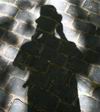I am suffering from hat hair at the moment, that hairstyle you get when you spend most of the day wearing a woollen hat because of the cold weather. I'm used to hat hair but I didn't expect to suffer from it in Mexico. A major motivation for being in Mexico at this time is so that I would avoid the European winter.
On entering Mexico we at first stuck to the Caribbean coast, enjoying the sun, sea and sand. We went to Tulum, a small town with a backpacker-driver economy, which has a long stretch of postcard perfect beach with wooden cabins tastefully placed along the beach and beach-side bars every kilometre or so. Even better than the beach were some Mayan ruins, also called Tulum, which are perched on a clifftop right on the edge of the sea. The combination of old stone temples and houses adjacent to the bright blue Caribbean waters is not bad at all.
From Tulum we made a brief foray inland to Chichen Itza, more Mayan ruins in the jungle. The centrepiece of Chichen Itza is a stepped-sided pyramid with a hole in the top through which the sun shines twice a year and making a shadow that looks just like a 50 metre serpent that slithers over the pyramid as the sun rises. Or so they say. It happens in March and September so I couldn't see first-hand proof. In the Mayan heyday it was a place of regular human sacrifice, as were all old Mayan centre. One particular Mayan method of sacrifice, which I called the Temple of Doom method, was for four priests to bend a victim's back over a stone altar while the high priest pulled out the living victim's heart. Apparently it helped the priest to communicate with the gods. A brochure claimed that the temples at Chichen Itza have engravings showing this happening but I couldn't find them.
Now completely full of Mayan ruins, I vowed to avoid them for the rest of my trip. We visited Merida and Campeche, a couple of towns where real modern-day Mexican life takes place, rather than just catering for tourists. We weren't really keenly interested in visiting these towns, we were simply postponing a 12 hour overnight bus journey into the mountains.
Having finally made the bus trip, I am in San Cristobal de las Casas. This is a beautiful old Spanish colonial town, 2100 metres above sea level. It is supposed to be warmish in the day and cold at night. Unfortunately we caught a cold snap, so it is cold in the day and freezing in the night. So cold that we had to visit the local market to buy scarves and gloves. It seems almost every gringo here has been caught unaware by the cold, because they are all wearing the Mayan woollen hat with bright patterns and earflaps, available in bulk at the local market.
Yesterday I made a daytrip to a nearby village called San Juan Chemula. This village has a bizarre church. From the outside the church looks like a typical colonial style Catholic church. But the priest was kicked out of the town 35 years ago and the church was taken over by the religious practices of the indigenous people. Instead of seats the inside of the church is covered with pine needles, thousands of burning candles and bright ribbons. The interior walls of the church are lined with various totems to represent traditional Mayan beliefs, with "positive energy" symbols on the north wall and "negative energy" symbols on the south wall. Doors, altars and windows are aligned to welcome the rising sun (the sign of life) and shut out the setting sun (the sign of death).
Local witch doctors sit on the floor and perform ceremonies to heal sick people using dying chickens and soft drinks, particularly Coca-Cola, Fanta, and Sprite. Apparently the burping caused by soft drinks helps expel sickness or evil. I watched a witch doctor coat a man with some combination of greasy, slimy ingredients.
I was fortunate enough to visit San Juan Chemula during a week long ceremony to honour Saint something-or-other, who is nominally the patron saint of the church, but has been reinterpreted to represent a Mayan god. Streams of people dressed in white and black sheepskin coats marched into the church accompanied by Mariachi musicians. They all carried large bunches of flowers and incense, sang and bowed their heads, and listen while the Mariachis blasted their off-key trumpets and strummed their guitars for 30 seconds at a time.
Tonight I am catching another overnight bus, this time hopefully to a place where hat hair is only a distant memory.
Thursday, January 20, 2005
Subscribe to:
Post Comments (Atom)

No comments:
Post a Comment